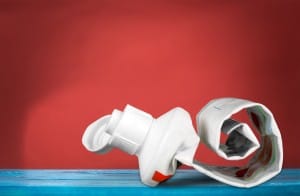Toxic Chemicals in Your Toothpaste?
[This article was previously published in the spring issue of The Cultivator, Cornucopia’s quarterly newsletter.]
by Jérôme Rigot, PhD
Farm and Food Policy Analyst at The Cornucopia Institute
 |
Toothpastes, even “natural” toothpastes, vary greatly in the ingredients they contain, some of which are questionable or potentially toxic. This is alarming when one considers that the mouth membrane is one of the most absorbent areas of the body, and that the average American will use about 20 gallons of toothpaste over her lifetime. Children are vulnerable to an even greater risk of exposure.
Help is needed to decode the hard-to-understand toothpaste ingredient labels, so Cornucopia is developing a new tool to do just that.
Cornucopia’s detailed report, slated for release this spring, will discuss specific ingredients to avoid – such as carrageenan – and will include a web-based buyer’s guide to help consumers make educated decisions when buying dental hygiene products.
Toothpastes are divided into two broad categories. One includes mass market brands, such as Crest®, Colgate®, Arm & Hammer®, Aquafresh®, Ultra Brite®, Sensodyne®, etc. The second contains the premium toothpastes, including those marketed as “natural.”
The use of “natural” ingredients in a toothpaste product does not necessarily imply that the highest-quality and healthiest ingredients were used across the entire brand, nor does it ensure the product is free from unnecessary or potentially dangerous additives. However, some excellent options exist that use organic ingredients and shun synthetic additives.
When it comes to choosing among the many natural toothpastes available, it is a challenge to wade through the list of difficult-to-pronounce ingredients and exaggerated health claims made by the industry.
A number of “Natural” toothpaste manufacturers use the same synthetic ingredients (usually petrochemicals) that are commonly used in mass-marketed toothpastes. These may include: sodium lauryl sulfate (SLS), sodium laureth sulfate (SLES), triclosan, formaldehyde-releasing preservatives, natural flavors, carrageenan, and fluoride, among others.
Toothpastes are considered cosmetics and, as such, are regulated by the Food and Drug Administration (FDA) under the Federal Food, Drug, and Cosmetic Act (FFDCA).
The cosmetics title of the FFDCA, which has not been amended significantly since it was enacted more than 75 years ago, provides virtually no power to perform even the most rudimentary functions to ensure the safety of the estimated $71 billion cosmetic industry.
The FDA lacks authority to make sure cosmetic products and ingredients are safe; thus, regulatory weakness and loopholes allow for the use of questionable ingredients in personal care products that could negatively impact the health of users.
In fact, according to the FDA, “Cosmetics products and ingredients do not need FDA approval before they go on the market. The one exception is color additives, which must be approved for their intended use.”
The FDA restricts or prohibits only 11 ingredients for use in cosmetics. In stark contrast, the European Union prohibits over 1,300 and restricts more than 250.
In effect, cosmetics are regulated by the free market. If enough concerns are expressed by consumers, accompanied by decreased sales and, perhaps, the initiation of legal actions, a company may move to modify or remove an ingredient from its products.
Though most such problematic ingredients are found only in small quantities in toothpastes, consider the following:
- The mouth mucosa is extremely
effective at absorbing chemicals; that is why some medications are administered sublingually (under the tongue), where they directly enter the blood, by-passing the gastro-intestinal tract and initial liver metabolism. - We are continuously exposed to a mixture of potentially toxic chemicals everyday via the air we breathe, the water we drink, and the food we eat. Do we really want to add to our overall exposure by using toothpastes that contain potentially dangerous chemicals?
- Many of these compounds have not been thoroughly tested, or have only been tested individually. Synergistically, these compounds may be more toxic than they are individually.
Keep an eye on Cornucopia’s website (cornucopia.org) for the release of this important tool designed to help you decode your toothpaste and make the most informed decisions about your daily brushing routine.
Why Would a Farm Policy Group Research Toothpaste?
At The Cornucopia Institute, we work at the unique intersection of the environment, humane animal husbandry, economic justice for our country’s best farmers, and human health.
Every five years, as mandated by Congress, the National Organic Standards Board reviews every synthetic/non-organic material approved for use in organics. Five years ago, when carrageenan was up for review, we published a report, based on the preponderance of independent, peer-reviewed scientific studies, indicating this seaweed-based material is a potent inflammatory agent and is associated with cancer. Corporate interests on the NOSB didn’t take the concerns seriously.
Many food producers, pet food manufacturers, and now even toothpaste brands have since removed carrageenan from their formulations due to the increased public awareness fostered by Cornucopia. It’s embarrassing that companies are more proactive than organic policymakers. Carrageenan returns to the NOSB agenda for review this spring.
In addition to carrageenan, many toothpastes – even “natural” brands – may contain toxic chemicals, carcinogens, and endocrine disruptors, including the antimicrobial triclosan.
Some of the very best brands not only exclude these problematic materials, but also use certified organic agricultural ingredients, like coconut oil, to make their products.
Anything you put on your body, any fragrances you breathe in, and any cleaning materials you bring into your home are going to end up in your bloodstream. Don’t undermine the good you are doing for yourself and your family, in terms of eating an organic diet, by dosing yourself with toxic chemicals if you can avoid them. The best toothpastes will clean your teeth, keep your breath fresh, and will not poison you.
– Mark Kastel

